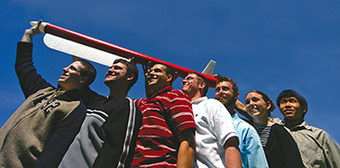And If Rockets Had Wings...

What goes up like a rocket, changes into a plane, then glides under controlled flight? For Christopher Wilkins ’05, Erik Palitsch ’05, Samuel Lee ’05, James Rollo ’05, and a team of Rensselaer students, it’s their senior capstone project. It’s called a morphing rocket — a rocket that changes inflight to an aircraft with wings and control surfaces to facilitate directed flight.
The morphing rocket idea is itself morphed from another student design project, funded by Northrop Grumman through Rensselaer’s O.T. Swanson Multidisciplinary Design Laboratory (MDL), to design and prototype changing — or morphing — wing shapes for aircraft and missiles. Paul Marchisotto ’79, vice president, advanced systems and technology, Northrop Grumman Integrated Systems Sector, and a member of Rensselaer’s Key Executive Program, sees great value in this work for the corporation and the students. “Northrop gets lots of fresh ideas and non-traditional concepts and the students re-ceive real-world design, modeling, manufacturing, and testing experience.”
Examples of morphing wings can be found on the F-14 Tomcat fighter jet and the B-1 bomber, which both feature a variable-sweep wing that allows short field take-offs, which then can be swept back for supersonic flight. In essence, a variable-sweep wing provides greater mission flexibility for the aircraft.
A morphing rocket uses the idea in reverse: It takes off at maximum speed, achieves the desired altitude, then deploys the folded-back wings into a lift-inducing forward position, slowing the craft down to provide loitering or directed flight capabilities. The civilian and military applications are numerous: reconnaissance, targeted ordnance strikes, and close-in weather analysis, such as into the eye of a tornado or hurricane.
To date, however, morphing wings have been associated with jets and airplanes, not rockets. Wilkins and Palitsch decided to explore those uncharted skies under the guidance of Mark Steiner, director of the MDL and clinical associate professor of mechanical, aerospace, and nuclear engineering, and Henrik Hagerup, associate professor of aerospace engineering. together, they outlined the parameters for this unusual capstone project and guided the project from conception to completion.
The team designed and built the 6-foot rocket over the course of a semester and scheduled a test flight on May 14. The flight objective was to launch, achieve altitude, deploy the wings, and observe flight characteristics. Under sunny skies but windy conditions, the 102-pound thrust rocket launched and completed all phases of burn and wing deployment. However, a holding pin failed under stress and one wing was lost. The emergency parachute was deployed and the craft safely returned to Earth. Despite the mishap, the team learned a lot, and was elated to see their dreams and hard work actually fly.
“It was an amazing success!” said Wilkins. “We started literally from scratch and designed our objectives, our testing protocol, and our action plan. Over the course of the semester, this team completed every one of our goals, and created a rocket, piece by piece, that flew, morphed, and returned safely. We’re all very proud of this achievement.
Source: Rensselaer Polytechnic Institute
















